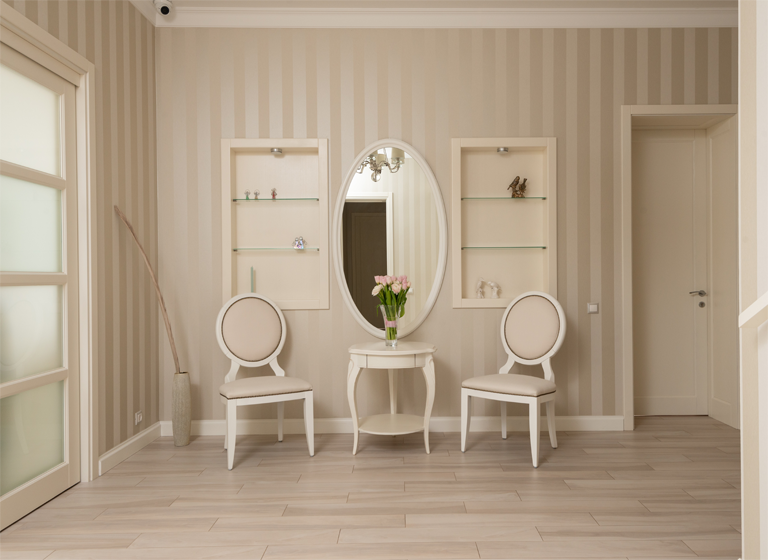
What is Classical Interior Design?
At first glance, when we notice the word classical, we associate it with the word classic, as they have the same roots, and many of us can draw the faulty conclusion that the words can be used interchangeably.
As opposed to the word classic, which is defined as “serving as a standard of excellence: of recognized value” according to the Merriam Webster Dictionary, the word classical stands for describing different works of the cultural movement, relating to the ancient culture of Rome and Greece. So how does that translate to Interior Design?
Developing in response to the flamboyant Rococo, the era defined by Neoclassicism aimed to reform and simplify our visual surroundings through decorative arts and architecture, among other aspects. Today’s popularity of buildings from the late 18th, early 19th century is a testament to the influence the Neoclassical style had on our lives. Of course, these buildings still serve as inspiration for contemporary architects.
But when it comes to buildings, the simple and sophisticated approach did not stop at its influence on the exterior; it also transformed the décor. Whilst different European countries had had some differences in their interpretation of the style, but the adaptation of the Neoclassical movement was definite. Therefore, the uniform characteristics of the style can be observed internationally in Europe, and the US as well.
Classical Interior Design relies on the Neoclassical movement as its primary source of inspiration, but despite having been around for centuries, the style has not lost its charm. In fact, when we refer to “Traditional Interior Design” , which tends to be one of the most sought after styles for family homes in the West, we refer to the Interior Design almost entirely derived from the Classical.
If you want to learn more about the origins of the Neoclassical Interiors and what are the key elements you need to create it, keep on reading!
What is Classical Interior Design?
Classical Interior Design is a style inspired by the revival of ancient Greco-Roman ideals, during the 18-19th century in Europe. This inspiration englobes the proportions, the simplicity and the colour scheme of the décor.
What usually defines neoclassical buildings from the outside, which is symmetry, horizontal and vertical line detailing, marble and brass finishes…etc. extends into the interiors, completed with appropriate furnishing and accessorising which allow the same key principles.
Classical interiors, even in their most contemporary interpretation, aim to create a simple and elegant design that will stand the test of time.
At Impera Italia, as the British heart of Italian decorative products and Venetian Plaster, we like to embrace tradition and products that are part of the Italian design heritage. With products that have been used for centuries, we are all about creating beautiful, timeless, and luxury wall finishes that will also stand the test of time, as the perfect backdrop for Classical Interiors.

What are the Origins of Classical Interior Design?
The origins of Classical Interior Design, as mentioned above, is entirely tied into the cultural movement of neoclassicism and has been around since, albeit with a few modifications.
The start of Neoclassicism can be traced back to the time around Pompeii’s rediscovery, and with that, the formal development of archeology. But as the ideals of enlightenment spread around the continent largely around the same time, the influence of the new way of thinking could have also influenced the popularity of Classicism as a cultural movement.
Rome is thought of as the birthplace of Neoclassicism, with the contemporary artists at the time completing their “Grand Tour” of Europe, Italy being one of the most important places on their list. As the Ottoman Empire was a threat at the time, Greece, being at its doorstep, was thought of as a more dangerous place to visit. Therefore, from the ancient world, Roman architecture and decorative arts became a primary source of influence, reinforced by the works of the Renaissance era.
The circulation of ideas and inspiration drawn from Italy, thanks to the “Grand Tour”, helped set off the movement of Neoclassicism.
At Impera Italia, a lot of our products, especially our wide range of Venetian Plasters were inspired by classical Italian design and architecture. Italian decorative plasters have been around for a long time, but recently have gained a newfound popularity, in part because of their versatility, and on the other hand, because of the classical finishes that we have seen as the cornerstone of traditional Italian architecture.
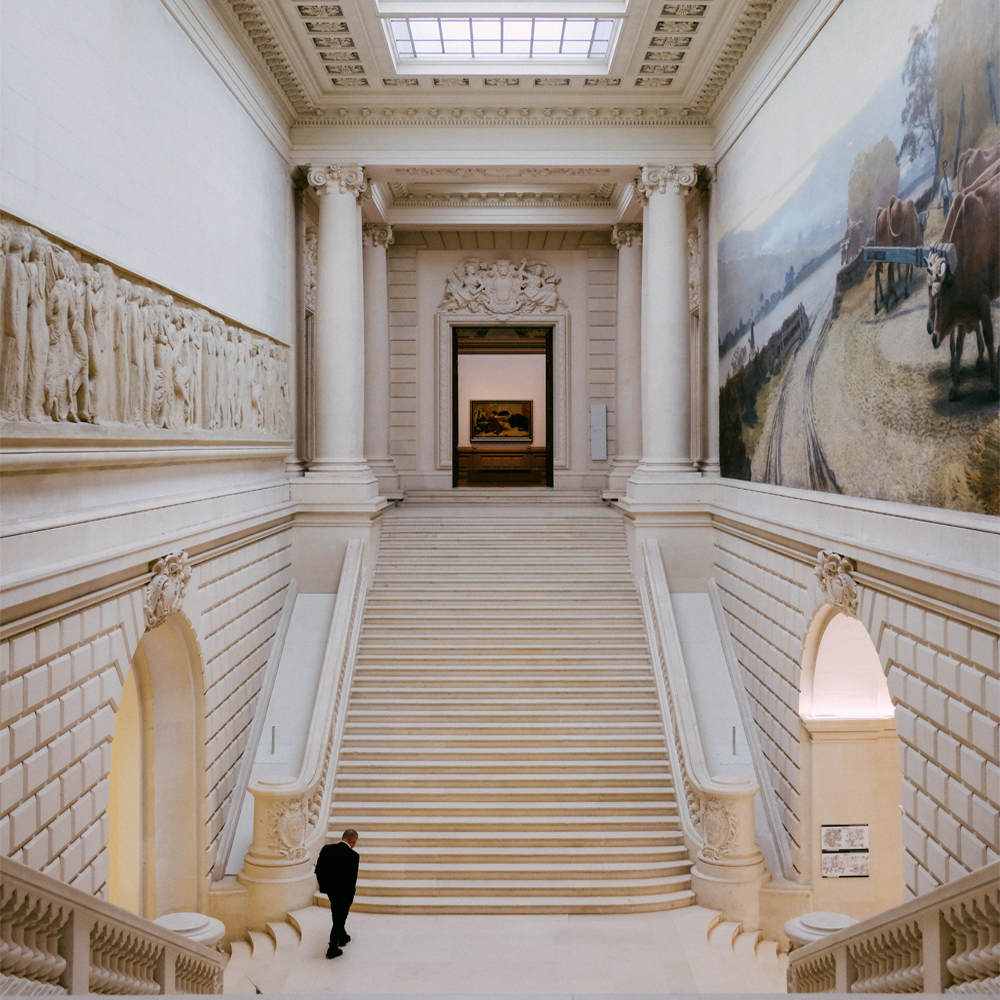
Does it have different versions?
Throughout Europe, and the US, the movement gained popularity and influence, especially in aristocratic circles.
As with other cultural movements, Neoclassicism also had its different versions through different countries, but its key characteristics can be observed through different countries. As the style aimed for simplicity more than anything after the grandeur of Baroque and Rococo, the uniform, symmetrical look is easy to observe especially in architecture and the visual arts. But Interior Design is no exception.
Whilst the Greco-Roman inspired movement started from Italy, the second phase, the Empire style, gained momentum during the Napoleonic era, Paris being at its forefront. The UK and the US were both heavily influenced by the movement, and important buildings to this day preserve the characteristics of the Classical style.
How to create a Classical Interior Design?
1. Harmonious colour scheme
When it comes to Classical Interiors, we tend to think of light neutrals; a lot of cream colours and beige with discrete patterns, or no patterns at all. Light pastels were heavily used during the 18th-19th century, when the Neoclassical style first appeared, but in the contemporary version earth tones tend to win.
Adding darker accents or incorporating in an overall darker theme is possible, but should be done if the room itself receives lots of natural light, and the colour palette remains harmonious. Our newest addition to our product selection, the Acrylomat Plus Emulsion paint boasts over 150+ colours, which provides you with plenty of options to create a perfect colour scheme!
If you want to experiment with extra opulent touches, try adding metallic paint either on a feature wall or as part of the panelling! A Textured Metallic Paint like Gymcin, or a Smooth Metallic Paint such as Sioloc or Infinity will give a subtle, but elegant look that will enhance your chosen colour palette, without being too much!
Click for the colour charts, with hand applied samples!
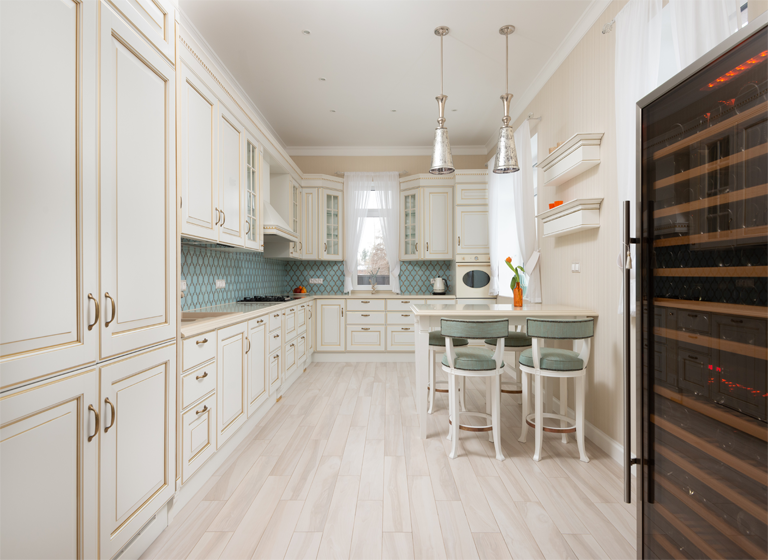
2. Panelling
Linear forms and details are key features in Classical architecture. It is therefore an important part of Classical Interior Design as well.
Opting for wainscoting or raised panelling on the walls can add a real Classical feel and look to your décor, and gives you the flexibility to paint it in any colour. Or to even mix two three different tones (and not colours), whereas opting for a wallpaper will take away the possibility.
If you want to add a contemporary touch, make sure to decorate with one of Italian Decorative Paints, such as Tintoretto! It was inspired by the traditional Venetian Plaster look, and gives a semi-matt, velvety finish that will give your walls an ultra-luxurious look!
As mentioned above, adding metallic paint on the inner part of the rectangular details, or on the panelling itself can add a modern feel to your walls, without making the wall look too busy! Our Metallic Paints, Infinity and Gimcyn Luxury boast a wide range of neutral colours, perfect for Classical Interior Design!
Click on the links below for our handmade colour charts!
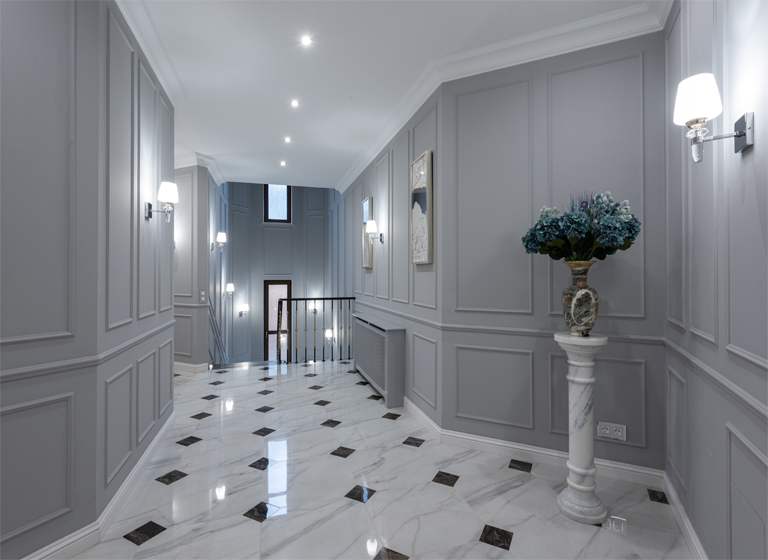
3. Venetian Plaster
Venetian Plaster is the cornerstone of Classical Italian interior design, especially in polished, marble-like finishes!
Opting for a beautiful Italian polished plaster, such as Stucco Veneziano or Grassello di Calce, can go a long way in creating a formal and timeless décor. Venetian Plasters have been around for a long time for a good reason, and this reason, aside from its versatility, is the luxurious finish you can achieve, on walls and ceiling that would not be possible with traditional paints and wallpapers!
Click here to browse our selection of polished Venetian Plasters!
4. Antiques
It goes without saying that Classical Interior Design is all about embracing tradition. Whilst the key principles of the style promote harmony, simplicity and symmetry, accessorising is usually responsible, at least partly, for creating the overall harmonious look!
Whether it’s accessories or furniture, incorporating pieces that have history will no doubt have a positive effect on your décor. Aside from being a sustainable option, a lot of antique pieces tend to keep or increase their value over time, depending on what it is and its condition of course.
But even if we don’t want to go overboard with tradition, it’s good to select pieces that are classic, rather than anything too trendy or too flamboyant.
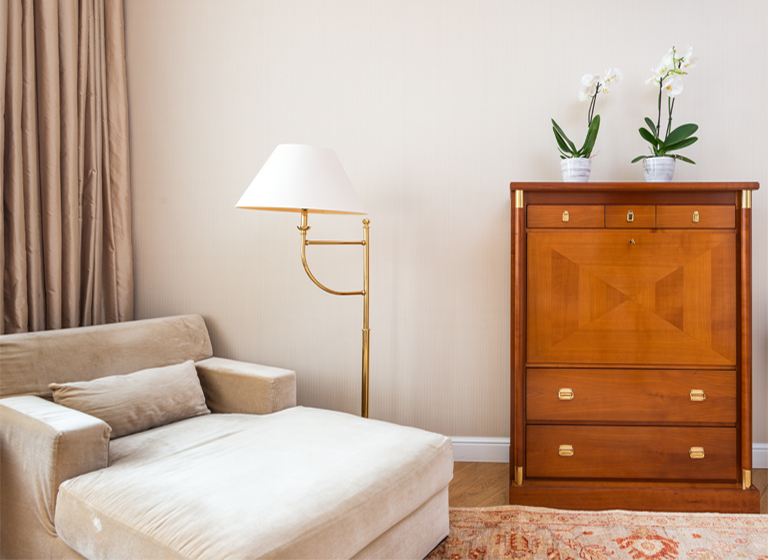
5. Straight Lines and Symmetry
The linear details were mentioned above, and have to be mentioned again, as it is one of the core principles of the style. And it goes hand in hand with symmetry.
When it comes to window treatment, frames, furniture or even patterns, the repeating of linear details is what creates symmetry in the overall look is that it looks neat and put together! Accessorising and the furniture layout should also embrace symmetry, having two of the same sofa, chair or plant is something we often see in Classical style homes.
6. Marble and Brass Finishes
Accent colours, despite being minor details, can add the extra finishing touch that will make your décor feel even more elegant and considered.
Marble, especially on counter tops and fireplaces are a characteristic feature of Classical rooms, both in the traditional and modern versions. As the Classical interior Design is all about timelessness, incorporating pricier but quality materials is essential.
When it comes to adding a pop of colour, rather than a colour, we see a pop of the metallic accents. Light brass finishes complement the usually neutral or pastel colour palette that describes classical rooms, and create a cohesive look if it’s repeated through different surfaces in the room!
To imitate the brass or bronze finishes, we recommend checking our metallic paints, such as Mineral, which can be applied on virtually any surface, and gives you the flexibility to customise different features or small details in your decor, such as breams or shelves!
If you want more flexibility than what solid marble can offer, or you want a more budget friendly option, check out our polished Venetian plasters, such as Luciano, Grassello di Calce or Venetian! Depending on the environment you choose the finish for, please consider the differences between acrylic and lime-based plasters, for example breathability!
For any questions and queries about our products or your next project, please contact our Showroom at 0333 012 4396 or [email protected]!
For London-based clients, we recommend visiting in person, so you can check the samples and the different finishes for every product we offer!
